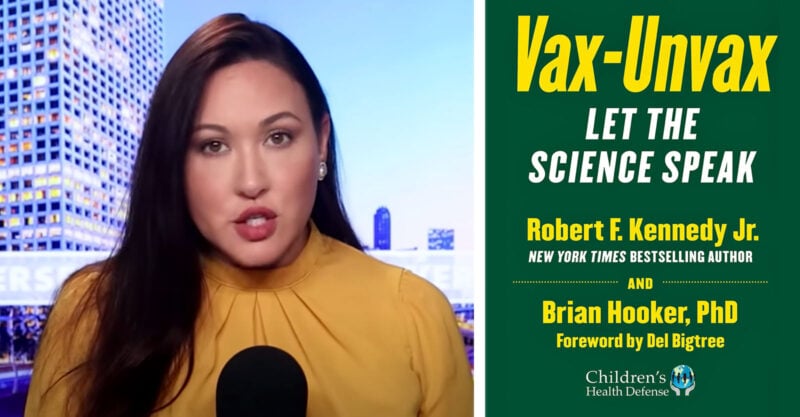Miss a day, miss a lot. Subscribe to The Defender's Top News of the Day. It's free.
When Brian Hooker, Ph.D., began surveying the scientific literature in 2019 for published studies comparing health outcomes of vaccinated individuals to those who were unvaccinated, he thought that data would be hard to find.
That’s because federal agencies like the Centers for Disease Control and Prevention (CDC) refuse to sponsor such research or give independent researchers access to that data, which the CDC collects in its Vaccine Safety Datalink.
But, Hooker, senior director of science and research at Children’s Health Defense (CHD), on Wednesday appeared on “The Kim Iversen Show,” where he told journalist Kim Iversen, “Lo and behold … there were studies hiding in plain sight.”
Hooker and Robert F. Kennedy Jr., CHD’s chairman on leave, found about 60 studies conducted prior to the COVID-19 pandemic and about 30 related to COVID-19 with a “vax-unvax” comparison.
They summarized the studies for the general public and published them in their new book “Vax-Unvax: Let the Science Speak.”
Iversen asked Hooker why the federal government wouldn’t do these kinds of studies or make the data available.
The U.S. Food and Drug Administration (FDA), Hooker said, should be doing post-approval studies on risks associated with individual vaccines and groups of vaccines given together, but “they’ve been woefully asleep at the wheel.”
“It seems like they’re trying to eliminate the control group” of unvaccinated individuals. As justification, he said, “You hear this mantra that it’s somehow amoral to withhold life-saving vaccinations” from those in the control group, “specifically to children, and now to adults” with COVID-19.
In the case of COVID-19, Hooker said, Pfizer started off its study with a control group, but then offered the vaccine to the people in the control group only six months into the study. That effectively eliminated the control group.
One of the key takeaways of the book is the “extreme nature” of injuries associated with the COVID-19 vaccine, Hooker told Iversen. The book highlights over 30 studies showing “strong, significant relationships” between the COVID-19 vaccine and myocarditis, pericarditis, Bell’s palsy, shingles and other cardiac and neurological disorders.
Because the regulatory agencies recommended the COVID-19 vaccine to pregnant women without any supporting data, the book also addresses that topic, Hooker said.
“Isn’t that insane?” Iversen asked, “I mean, insane to tell [that to] pregnant women. Pregnant women are typically the most protected group of people. And instead they’re like, ‘Oh, we never did any test, but go ahead, take it. I’m sure it’s fine.’ I mean, unbelievable.”
Asked why he thought the vaccines were pushed with so little data, Hooker cited several reasons.
Pfizer, he said, “had 56 billion reasons” — and they make payments to the FDA, which has a conflict of interest, Hooker said.
“There is an ideology that is ‘vaccinate, vaccinate, vaccinate — that is how we get ourselves out of a pandemic,’” he said, and that ideology displaced any focus on early treatments.
Hooker also believes there were more insidious forces at play, for example those tied to the concentration of private power at the World Health Organization, which receives a lot of funding from Bill Gates.
Vax vs. unvax: the childhood schedule
Another key takeaway from the book, Hooker said, came from comparing children who had received all the shots on the CDC’s schedule of recommended childhood vaccines to those who were unvaccinated, or were unvaccinated only during the first year of life.
“Overwhelmingly the unvaccinated children were much healthier in terms of chronic illnesses, ailments as well as infectious disease,” Hooker said.
“And so to me, that was a very, very stark contrast because vaccination has been a part of the fabric of society in the United States for a very, very long time,” he added.
In some studies, he said, children who got all the vaccines on the schedule had more respiratory infections, more pneumonia and more ear infections.
Iversen asked whether there was a “cutoff,” a time when that finding was untrue, before the CDC added so many vaccines to the schedule. Surely, she said, there were some vaccines that were beneficial to children.
“It’s hard for me to just imagine we’ve been gaslit completely, and vaccines are just totally and completely useless, and it’s just a money-making scheme by Big Pharma,” she said.
Hooker said the problem is with so few studies, it is difficult to determine if there was a cutoff. But he suggested that cutoff might have coincided with the passage of the National Childhood Vaccine Injury Act of 1986, which gave legal immunity to pharmaceutical companies for injury and damages associated with their vaccines.
“After that, the pharmaceutical industry started to add more and more vaccines to the schedule in conjunction with the Centers for Disease Control,” he said.
Before the Vaccine Act, children received 11 vaccines. Now, he said, there are over 53 — and 21 of those are administered during the first year of life.
“I think you have a very valid point that at some point there was a benefit,” Hooker said. “But now I think that we’re looking at diminishing returns.”
“And we’re also looking at untested protocols of giving infants as young as 2 months of age, six vaccines — six different needle sticks — all in the same visit,” he added, “and that’s never really been studied.”
Hooker and Iversen also discussed vaccines that are effective at preventing the diseases they are designed to prevent, such as the measles vaccine, and those that are ineffective at doing so, like pertussis.
But, Hooker said, improvements in public health, such as better sanitation, had put a lot of these diseases — and mortality associated with them — in decline even before the vaccines were introduced.
So, he said, it is important to back up and look at the entire construct being used to determine whether vaccination is warranted.
Hooker said he and Kennedy don’t give medical advice in the book. Their purpose was to “distill down the science,” he said, particularly around adverse events, long-term harm and the chronic disorders that can follow vaccination.
Watch here:









